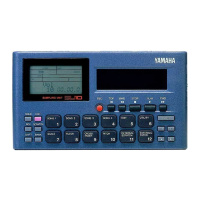What to do if Yamaha SU10 cannot send MSDS sample dump?
- SSamuel MyersSep 13, 2025
If your Yamaha Recording Equipment cannot send an MSDS sample dump, ensure that the receiving side is correctly set up and has sufficient memory to receive the data.

What to do if Yamaha SU10 cannot send MSDS sample dump?
If your Yamaha Recording Equipment cannot send an MSDS sample dump, ensure that the receiving side is correctly set up and has sufficient memory to receive the data.
| Polyphony | 8 voices |
|---|---|
| Sampling Rate | 32 kHz |
| Sampling Resolution | 16-bit |
| MIDI | In, Out |
| Display | LCD |
| Power | 6 x AA batteries or AC adapter |
| Type | Sampler |
| Outputs | Line Out, Headphones |
| Effects | Filter |
| Weight | 450 g (without batteries) |
| Inputs | Line In |
Explains document conventions, button labeling, and icons used.
Provides a concise overview of the SU10's features and purpose.
Details the four main operating modes: PLAY, REC, EDIT, and UTIL.
Explains what samples are and how they are stored in the SU10.
Describes the process of converting analog signals into digital samples.
Explains the organization of samples into banks and pads.
Introduces modes independent of sampling for live performance effects.
Describes the song sequencing feature for arranging sample playback.
Covers MIDI capabilities for data transfer and remote control.
Details the layout and function of the SU10's top panel controls and display.
Describes the connectors and switches located on the rear of the unit.
Covers controls and jacks on the right side of the SU10.
Explains the various sections and indicators of the SU10's LCD screen.
Explains how to power the SU10 using an AC adaptor or batteries.
Instructions for inserting and replacing batteries in the SU10.
Illustrates typical audio and MIDI connection setups for the SU10.
Steps required before playing samples or songs, including connections and mode selection.
How to replay individual samples by selecting banks and pads.
Introduces features like HOLD for continuous or extended sample playback.
How to play samples backwards for a reversed sound effect.
Enables playing a sample at multiple pitches using the pads.
Details the distinctive ribbon controller and its applications.
Using the ribbon controller to dynamically change sample pitch.
Using the ribbon to dynamically control filter cutoff frequency.
Simulating DJ scratch effects using the ribbon controller.
Mixing sample playback with realtime audio input using the ribbon.
Outlines the steps involved in recording new samples onto the SU10.
How to enter recording mode and choose a destination pad for a sample.
Explains how to adjust parameters like Gain, Grade, and Format before recording.
Describes the process of recording sequences of pad and button actions into songs.
Provides tips and precautions for designing better song performances.
Introduces the various ways to edit samples for playback control.
Lists the available parameter-setting and operation-based editing functions.
Outlines the general steps for entering EDIT mode and selecting a sample to edit.
Sets the playback direction and loop method for samples.
Determines how samples are triggered and whether they loop.
Adjusts the relative volume of individual samples.
Assigns samples to groups that prevent them from playing simultaneously.
Selects the MIDI note number assigned to a pad for external control.
Sets the playback start point for a sample.
Sets the start point of the loop segment within a sample.
Sets the playback end point for a sample.
Function to copy sample content to another pad.
Function to move sample content to a different pad.
Divides a sample into two parts on different pads.
Removes leading/trailing data to free memory, cannot be undone.
Removes a sample entirely from memory.
Introduces the UTILITY mode for system settings and MIDI operations.
Explains how to enter and navigate the UTILITY menu and its sub-utilities.
Allows pre-setting recording parameters like Grade, Pitch, and Input Source.
Configures MIDI channel, device number, and other MIDI-related settings.
Sets the MIDI channel for communication.
Sets the SU10's device number for system exclusive messages.
Selects whether the SU10 pads control SU10 playback or are controlled externally.
Assigns a controller number to the ribbon for external control.
Reinitializes MIDI note-number assignments for pads.
Deletes all MIDI note-number assignments.
Utility for backing up SU10 data to or loading from an external device.
Sends a bulk dump of SU10 data to an external device.
Assigns the packet interval for bulk-dump transmissions.
Dumps individual samples in MIDI Sample Dump Standard format.
Allows deletion of selected songs from memory.
Protects banks or songs from accidental editing or deletion.
Resets the system by deleting all data or resetting parameters to defaults.
Lists and explains common warning messages encountered during operation.
Describes potential errors related to MIDI communication and data transfer.
Explains issues arising from problems with the SU10's internal memory.
Provides an overview of the SU10's key features and capabilities.
Describes the SU10's custom LCD screen.
Lists the physical controls and components on the SU10's panel.
Details the types and functions of all input and output connectors.
Specifies the output signal levels for LINE OUT and PHONES.
Specifies the input signal levels for LINE and MIC.
Details the power sources, including AC adaptor and batteries.
Specifies the physical size of the SU10 unit.
States the weight of the SU10 unit.
Lists the items included with the SU10, such as the manual and CDs.